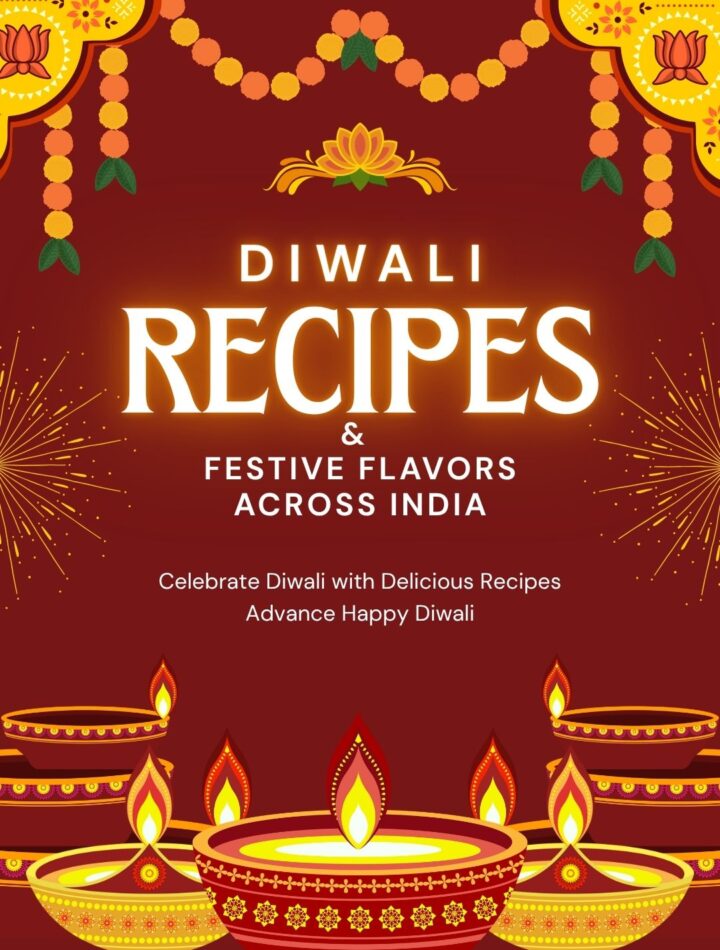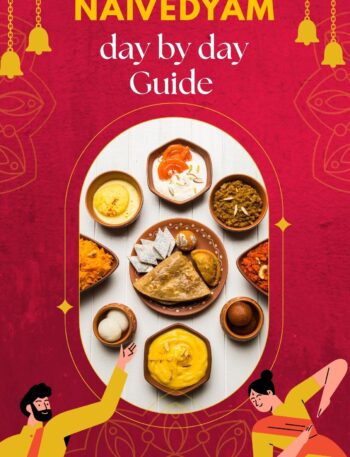Growing up in Chennai, the real magic of Diwali began two days before the festival. That’s when our kitchen transformed into a bustling sweet-making factory, filled with the intoxicating aroma of jaggery melting in ghee and rice flour crisping in hot oil. My grandmother would start preparing Adhirasam and murukku, carefully storing them in large tins, ready to be distributed to neighbors and relatives on Deepavali morning. But what I looked forward to most was the feast on the day itself — especially her legendary Paya with soft Idiyappam. The rich, slow-cooked mutton trotters, infused with spices and simmered until the marrow melted into the broth, was more than a dish — it was the heart of our celebration. Every sip felt like a warm hug, and every bite reminded me that Deepavali is about indulgence, family, and love.
The Preparation -Two Days Before the Festival
In South India, Deepavali preparation is an art that begins well before the actual day. Two days prior, our entire extended family would gather at my grandmother’s house for the grand cooking marathon. The women would divide tasks — some would roast rice flour for murukku, others would prepare the jaggery syrup for Adhirasam, while the younger ones (including me) would be assigned the “simple” task of shaping Besan Ladoo or rolling coconut balls.
My mother’s station was always the murukku press. She would use a brass press and create the most perfect spirals — crispy, golden, and impossibly addictive. The trick, she’d say, was in the consistency of the dough and the temperature of the oil. Too hot, and they’d brown before cooking through. Too cool, and they’d absorb oil like a sponge.
My aunt would set up her station for seedai — those tiny, addictive rice flour balls that required incredible patience. Getting them to puff up perfectly without cracking was an art she’d mastered over decades. Another aunt specialized in thattai, those crispy, savory discs that would shatter delightfully with every bite. Each aunt had her signature specialty, and together they created an arsenal of snacks that would last well beyond the festival.
My grandmother, meanwhile, would make the Adhirasam. The jaggery had to be melted to exactly the right consistency — not too thin, not too thick. The rice flour, soaked and sun-dried days earlier, had to be ground to powder so fine it felt like silk between your fingers. And the frying? That required patience I didn’t possess then but deeply appreciate now. Each piece would puff up slowly in the oil, transforming from a humble disc into a beautiful, porous sweet that would melt on your tongue.
These sweets weren’t just for us. They were currency of love and community. Large dabba containers would be lined up, each labeled with a neighbor’s or relative’s name. On Deepavali morning, we’d make our rounds, delivering these homemade treats and receiving others in return. It was how the entire neighborhood celebrated together — one tin of murukku at a time.
Deepavali(Diwali)Day -The Festival Before Amavasya
Here’s what many people outside South India don’t realize — we celebrate Deepavali(Diwali) on the day before the new moon, not on Amavasya itself like in the North. This Naraka Chaturdashi, the day Lord Krishna defeated the demon Narakasura, is our main celebration day. It’s why the festival feels different in timing and energy between the regions.
The day would begin in complete darkness, sometimes as early as 4 AM. The pre-dawn oil bath, or Abhyanga Snanam, was the most important ritual. My grandmother believed this sacred bath washed away not just physical impurities but also the year’s negative energies. We’d apply warm oil infused with herbs, then bathe before sunrise — a practice that felt torturous when you’re twelve and wanted to sleep, but now I understand its deeper significance.
Then, finally, we’d wear our new clothes. That moment of slipping into brand-new fabric that smelled of freshness and possibility? Pure joy.
As dawn broke, the kids would burst crackers. Unlike the evening celebrations of North India, our Deepavali was a morning festival, celebrated in the gentle light of sunrise. The house would already be fragrant with the sweets and snacks made earlier, and now it was time for the feast.
The Feast: Breaking Free After Purattasi
Most South-Indians fast during the month of Puratasi, and Deepavali is their grand liberation.
The breakfast spread in our house was unlike any other day of the year. Steaming Idiyappam would be piled high, waiting for the rich Paya that had been simmering since the night before. kal dosa — those thick, spongy dosas — would come straight off the griddle. There was chicken korma, fragrant and rich, and egg bread that combined the heartiness of eggs with soft, pillowy bread. This wasn’t just breakfast, this was indulgence on a plate.
For lunch, my family would go all out with non-vegetarian preparations. My mother’s Chicken Curry, with its roasted spices, coconut, and curry leaves, was something I love “just to smell.” The gravy was thick, rich, and so flavorful that I would sop it up with the last piece of Poori.
But nothing, and I mean nothing, could compete with my grandmother’s Paya. She’d start it the night before, slow-cooking the mutton trotters with ginger, garlic, whole spices, and just the right amount of chili. By morning, the broth would be golden, rich, and so full of flavor that you could eat it as a soup. But the traditional way was with Idiyappam — those delicate rice noodle nests that would soak up the broth perfectly. The meat would be fall-off-the-bone tender, the marrow enriching every spoonful. This was the dish that made Deepavali feel complete.
The rice course was obviously Mutton Briyani with chicken fry, chicken 65, and prawn thokku and raita on the side
North Indian Diwali
Years later, I got a glimpse into how our North Indian neighbors celebrated Diwali, and I was fascinated by how different it felt. While I’d already celebrated on Naraka Chaturdashi, they were just getting started.
The North Indian Diwali unfolds over five days, each with its own significance and rituals. It begins with Dhanteras, when people shop for gold, silver, or new utensils — the markets stay open late, gleaming with precious metals and hopeful shoppers. Then comes Choti Diwali, which corresponds to our Naraka Chaturdashi but is just a prelude to the main event.
The real celebration happens on Amavasya — the new moon night — when families perform Lakshmi Puja. This is when the diyas come out in full force, rangolis bloom on every doorstep, and the night sky lights up with fireworks. The energy is different from our morning celebration — it’s about welcoming the goddess of wealth into homes that have been cleaned and decorated to perfection.
The next day brings Govardhan Puja and the tradition of Annakut — literally “a mountain of food.” Temples and homes prepare elaborate vegetarian offerings, sometimes fifty-six or even a hundred different dishes, presented to Lord Krishna. Then the festival concludes with Bhai Dooj, a beautiful celebration of the bond between siblings.
What struck me most was how the North Indian Diwali was predominantly vegetarian. Where my family would prepare rich mutton and chicken dishes, North Indian families created equally elaborate spreads entirely without meat. Their tables would groan under Paneer Butter Masala, Chana Masala, Dal Makhani so creamy it felt sinful, and Malai Paneer that was rich enough to make you forget about meat entirely.
The sweets, though — those were a revelation. While we had our Adhirasam and murukku, North Indian sweets felt like an entirely different language of indulgence. Kaju Katli arranged in perfect diamonds, Gulab Jamun swimming in rose-scented syrup, crispy Mathri, and elaborate Puran Poli made by hand. The Besan Ladoo melted on your tongue, each bite leaving behind the nutty sweetness of roasted gram flour and ghee.
Two Traditions, One Spirit
The beauty of celebrating Diwali across India is discovering that our differences make the festival richer, not lesser. The South Indian morning celebration on Naraka Chaturdashi and the North Indian evening celebration on Amavasya might seem like contradictions, but they’re really two verses of the same song.
Our emphasis on non-vegetarian feasts isn’t just about indulgence — it’s deeply woven into our cultural and religious calendar. After observing Purattasi fasting, Deepavali marks the joyous return to abundance. The victory over Narakasura is celebrated with communal feasts where nothing is held back. It’s about gratitude, prosperity, and the simple pleasure of gathering around a table laden with love.
In the North, the vegetarian emphasis during Diwali reflects different religious traditions and the sacred nature of Lakshmi Puja. But the sentiment is identical — gratitude for blessings, prayers for prosperity, and the warmth of family. Whether someone is making murukku two days in advance or preparing fresh jalebis on the day of Lakshmi Puja, the intention is the same: to share sweetness and joy.
These days, my own Deepavali has become a beautiful hybrid. I still wake up before dawn for the oil bath — some traditions run too deep to abandon. I make my sweets and snacks a day or two in advance, storing them in those same steel dabbas my grandmother used. On Naraka Chaturdashi morning, I celebrate with a South Indian feast. But I’ve also learned to light diyas in the evening, prepare a North Indian spread, and appreciate both rhythms of celebration.
My table now might feature Rava Kesari alongside North Indian halwas, Paneer Tikka next to traditional Chettinad preparations, and Dal Fry served with Rasam. The confusion is delicious, and nobody complains.
The Memory in Every Bite
Every festival dish carries more than flavor — it carries memory, tradition, and love. When I make Khara Bath for Deepavali breakfast now, I’m transported back to my grandmother’s kitchen. I can hear her voice: “Listen to the mustard seeds. They’ll tell you when the ghee is ready.” I can feel her hand guiding mine as I learned to temper spices, the exact moment when curry leaves should hit the hot oil to release their full aroma.
My Adhirasam never quite matches hers, but I keep trying. Each attempt brings me closer to understanding not just the technique but the patience, the devotion, the love that went into every piece. The sweets we made two days before weren’t just food — they were prayers shaped by hand, blessings fried in ghee, and love packed in tins to be shared with everyone we cared about.
Even the simple preparations become profound during Deepavali. A Tomato Rice made with extra ghee and garnished generously isn’t just lunch — it’s abundance. Lemon Rice isn’t just tangy and bright — it’s sunshine on a plate. And Curd Rice at the end of the meal isn’t just cooling — it’s comfort, completion, and the promise that no matter how spicy life gets, there’s always something to soothe you.
A Festival That Transcends Regions
As I sit here with my grandmother’s recipe book — pages yellowed, stained with turmeric and ghee, filled with measurements like “handful” and “until it feels right” — I realize that Deepavali’s greatest gift isn’t uniformity. It’s diversity. It’s the fact that a festival can be celebrated in the morning in Chennai and at night in Delhi, that it can last two days or five, that it can feature mutton curry or paneer masala, and still be the same essential celebration of light, goodness, and family.
This Deepavali, I encourage you to explore beyond your tradition. If you’re from the South, try celebrating on Amavasya evening too — light those diyas at night and see how magical it feels. If you’re from the North, wake up before dawn on Naraka Chaturdashi and try that oil bath ritual — you might discover something profound in the pre-dawn darkness. Make both Chakkarai Pongal and Puran Poli. Serve Naan with South Indian curries. Create your own fusion that tells your story.
Because that’s what Deepavali really is — a story written in light and flavor, in sweets made with love days before and distributed with joy on the festival day, in the aroma of spices that announce that this day is special, in family recipes passed down through generations. It’s a reminder that India’s diversity isn’t something to merely tolerate but something to taste, celebrate, and savor.
May your Deepavali be filled with light, laughter, and the most delicious food. May you start preparing those sweets with joy, may your oil bath wash away all worries, may your diyas burn bright, and may your family gatherings overflow with warmth. And may you, like me, find beauty in both honoring your own traditions and embracing others.
Happy Deepavali! Deepavali Nalvazhthukkal! Diwali ki Shubhkamnayein!





This article is a delightful feast for the soul, quite literally! Who knew the difference between North and South Indian Diwali could be so… existential? From the precise jaggery game to the life-changing significance of the pre-dawn oil bath, its all there. My only slight concern is for the poor kid who had to learn the *true* meaning of patience with the frying. But honestly, the idea of two Diwali days – one to break fast, one to welcome wealth – makes so much sense! And the North Indian vegetarian spread? Pure indulgence in a different language. Now, if only theyd explained how to handle the confusion when you try to mix both styles and end up with Rava Kesari served with Rasam, perhaps. Overall, a beautifully diverse and delicious celebration of Indian festivity!